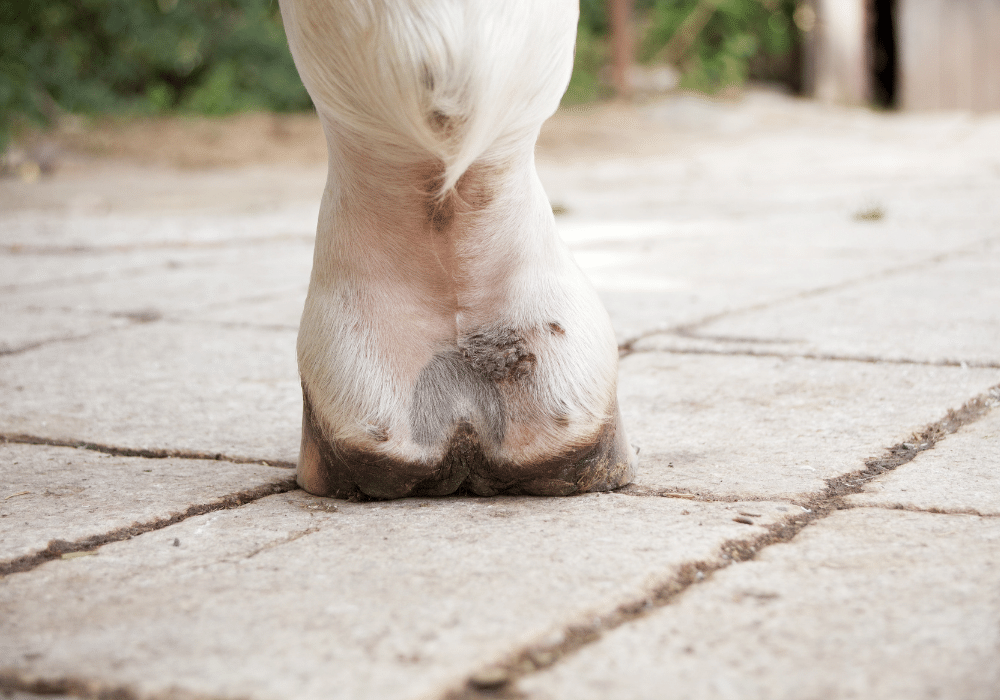Mud fever is a stubborn and unsightly skin condition that tends to affect the horse’s lower legs. Usually occurring in the winter months, mud fever is caused by prolonged exposure to wet, muddy conditions. Whilst mud fever can be very difficult to treat, knowing the symptoms and detecting it early can make it easier to manage. This blog article discusses the symptoms of mud fever.
What is Mud Fever?
Mud fever is actually a general term for a range of skin infections. These infections may be caused by different types of bacteria, fungus or mites. Other names for mud fever include pastern dermatitis or greasy heel.
Mud fever tends to occur in horses that have been exposed to wet, muddy conditions for prolonged periods. For example, standing in a boggy field can increase the risk of mud fever. When the skin is exposed to those wet, muddy conditions, it can become weak and damaged. This may cause the skin to become infected, resulting in what is often known as mud fever.
Leg mites can make the horse’s legs very itchy, causing them to scratch their legs. This can in turn result in skin damage and small wounds, which can become infected.
Mud Fever Symptoms
The symptoms of mud fever vary depending on the type and severity of the infection. Checking your horse’s legs daily will allow you to identify possible signs of mud fever earlier. If your horse has feathered legs, be sure to look underneath the feathers as the signs of infection may be more difficult to spot. The symptoms of mud fever include:
Reddened, irritated skin: Reddened or irritated skin is often the first sign of mud fever. By checking your horse’s legs daily, you can spot the early signs of a problem.
Hair loss: Hair loss can occur as the scabs drop off. It can also be a sign of irritation as the hair may come away as the horse scratches its legs. Matted hair can also be a symptom of mud fever.
Scabs: Crusty scabs on the heels and lower legs are a trademark symptom of mud fever. These scabs may be accompanied by discharge (pus).
Lameness: There may be heat, pain or swelling in the leg, and in severe cases the horse may be visibly lame. Mud fever can be painful and the horse may not tolerate the area being touched or handled.
Broken Skin or Wounds: Wounds may not always be a symptom of infection, but they should be checked and managed effectively to help prevent an infection. Horses can often injure themselves during exercise or turnout, and spotting a wound early will allow you to keep it clean and contact your vet if necessary.
Chronic Progressive Lymphoedema (CPL) can be mistaken for mud fever or pastern dermatitis in its early stages. CPL is a common and debilitating disease of the lymphatic system, which often affects heavily feathered horses such as cobs, Clydesdales and Shires.
Rain Scald
Mud fever tends to affect the pastern and the heel, but it may work its way up the leg in more severe cases. However, mud fever can occur on other parts of the body, such as the belly and the back. This is often known as rain scald. Again, prolonged exposure to wet, muddy conditions can cause the skin to become damaged and infected.
However, over-rugging can also trigger infection as the horse sweats underneath the rug. Rugs that are left on the horse when wet through can also harbour infection as they create the humid conditions in which bacteria thrive. The best way to prevent rain scald is by providing the horse with shelter from the rain and an appropriate rug when necessary. Rugs should also be checked daily and changed regularly.
Preventing Mud Fever
Ultimately, preventing mud fever is better than trying to treat it. Once an infection takes hold, it can be very difficult to manage. No single method will work for all infections, and we have to be careful to avoid aggravating the problem further.
The most effective method of preventing mud fever is to keep the horse’s legs clean and dry. Take a look at our guide to preventing mud fever for more information.
Mud fever is especially common in the cold, wet winter months as fields turn boggy. However, making chnages to your horse's management in the winter can help reduce the risk and severity of mud fever. Take a look at our guide to winter horse care for more information.
Avonvale Equine Vets | Independent Equine Vet Practice
Our highly qualified and dedicated equine vets, based in Upton, near Banbury, are experienced in diagnosing and treating a range of conditions. We offer free weekly zone visits for routine and non-emergency appointments, covering Warwickshire, Oxfordshire, Gloucestershire and Worcestershire. If you are looking for an independent, reliable equine vet practice with a team of experienced equine vets, Register your horse, pony, donkey or mule with us today.








